The AMD Radeon RX 480 Preview: Polaris Makes Its Mainstream Mark
by Ryan Smith on June 29, 2016 9:00 AM ESTPower, Temperature, & Noise
Given AMD’s focus on power efficiency with Polaris – not to mention the overall benefits of the move to 14nm FinFET – there is a lot of interest in just how the RX 480 stacks up when it comes to power, temperature, and noise. So without further ado…

When it comes to idle power consumption I'm posting the results I've measured as-is, but I want to note that I have low confidence in these results for the AMD cards. Ever since the GPU testbed was updated from Windows 8.1 to Windows 10, AMD cards have idled 3-5W higher than they used to under Windows 8.1. I believe that this is an AMD driver bug – NVIDIA’s cards clearly have no problem – possibly related to the GPU tested being an Ivy Bridge-E system. In this case I don’t believe RX 480’s idle power consumption is any higher than GTX 960’s, but for the moment the testbed is unable to prove it.
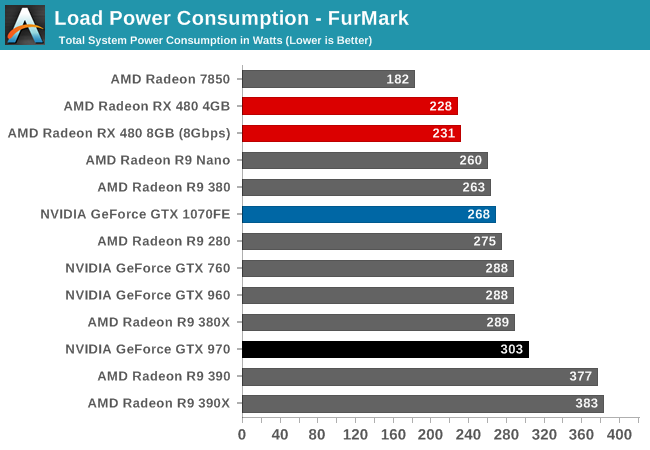
Traditionally we start with gaming load power before moving on to FurMark, but in this instance I want to flip that. As a power virus type workload, FurMark’s power requirements are greater than any game. But because it’s synthetic, it gives us a cleaner look at just GPU power consumption.
Among AMD’s cards, the RX 480 is second to only the Radeon HD 7850 in power consumption. Even then, as a GCN 1.0 card, the 7850 is one of the last AMD cards without fine-grained power states, so this isn’t a true apples-to-apples comparison. Instead a better point of reference is the GCN 1.2 based R9 Nano, which has a 175W TBP. Compared to the R9 Nano we find that the RX 480 draws about 30W less at the wall, which almost perfectly translates to the 25W difference in TBP. As a result we can see first-hand the progress AMD has made on containing power consumption with Polaris.
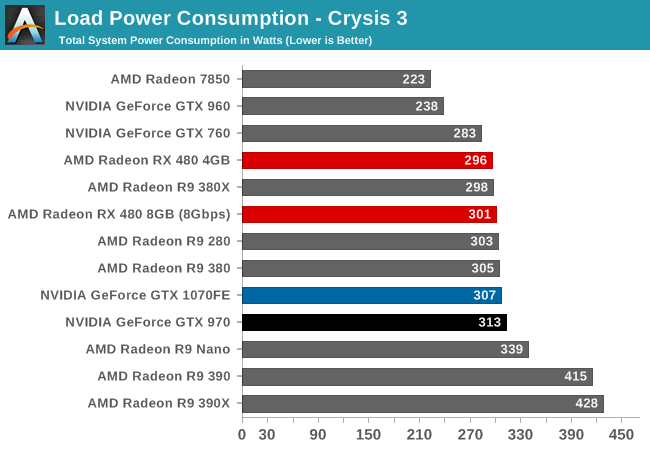
However things are a bit more mixed under Crysis 3. RX 480 is still near the top of our charts, and keeping in mind that higher performing cards draw more power on this test due to the additional CPU workload, the RX 480 compares very favorably to the rest of AMD’s lineup. System power consumption is very close to R9 280/380 for much improved performance, and against the performance-comparable R9 390, we’re looking at over 110W in savings. Hawaii was a solid chip from a performance standpoint, and Polaris 10 picks up where that left off by bringing down the power consumption to much lower levels.
The drawback for AMD here is that power consumption compared to NVIDIA still isn’t great. At the wall, RX 480 is only about 10W ahead of the performance-comparable GTX 970, a last-generation 28nm card. 1070FE further complicates matters, as its performance is well ahead of RX 480, and yet its power consumption at the wall is within several watts of AMD’s latest card. Given what we saw with FurMark I have little reason to believe that card-level power consumption is this close, but it looks like AMD is losing out elsewhere; possibly with driver-related CPU load.
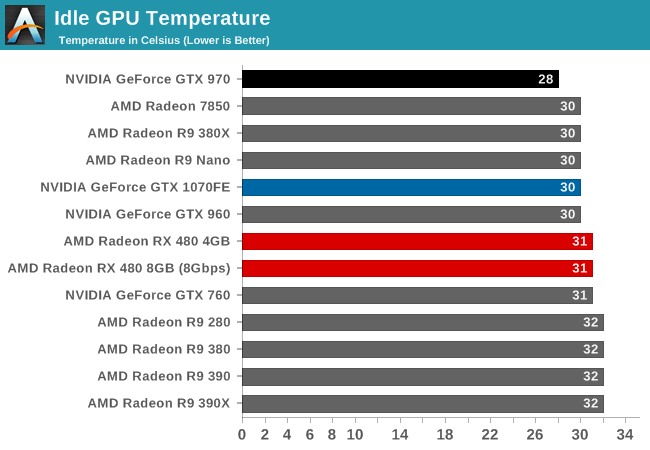
Moving on to idle GPU temperatures, there’s little to remark on. At 31C, the RX 480’s blower based design is consistent with the other cards in our lineup.
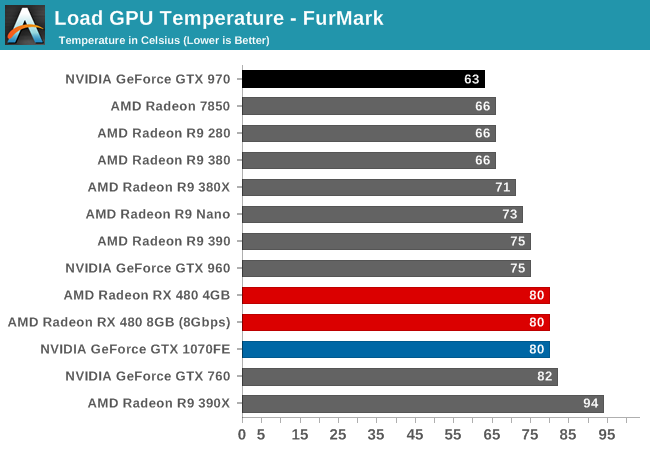
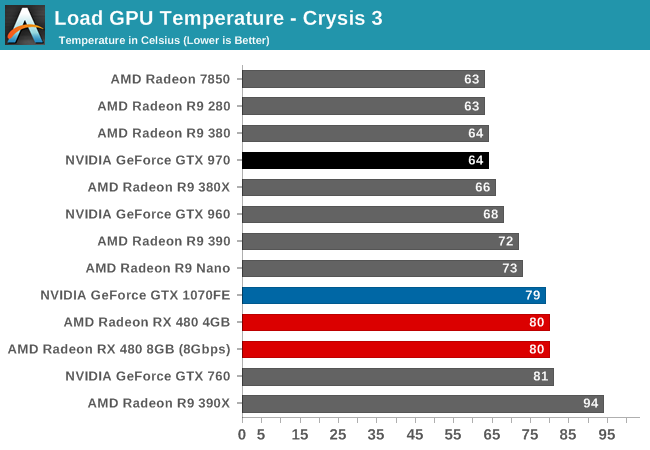
Meanwhile with load temperatures, we get to see the full impact of AMD’s new WattMan power management technology. The RX 480 has a temperature target of 80C, and it dutifully ramps up the fan to ensure it doesn’t exceed that temperature.

With idle noise levels RX 480 once again posts a good result. At 37.8dB, it’s in good company, only meaningfully trailing cards that idle silently due to their respective zero fan speed idle implementations.
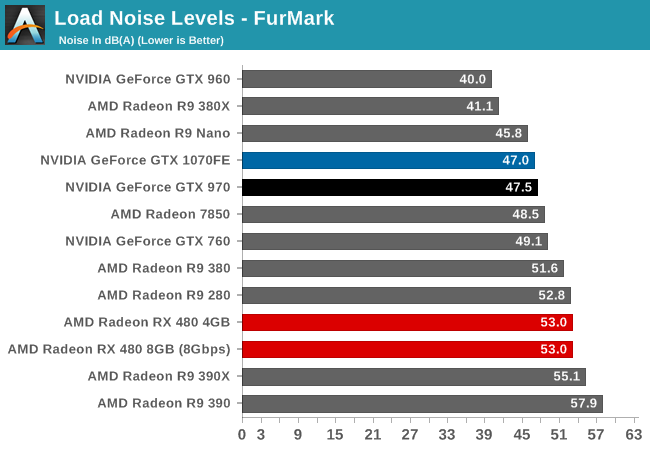
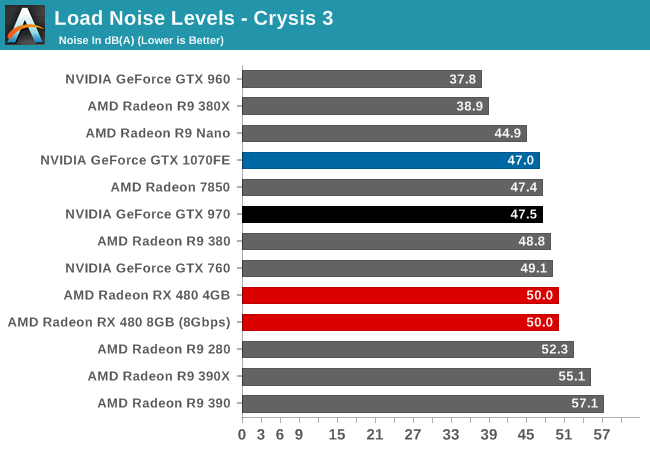
Finally, with load noise levels, RX 480 produces middling (but acceptable) results. Given that we have a mix of blowers and open air coolers here, the RX 480 performs similarly to other mainstream blower based cards. The $199 price tag means that AMD can’t implement any exotic cooling or noise reduction technologies, though strictly speaking it doesn’t need them.










449 Comments
View All Comments
ffleader1 - Thursday, June 30, 2016 - link
Can you maybe redo the test with updated driver.It seems that newer driver really makes a HUGE difference.
https://www.reddit.com/r/Amd/comments/4qiffg/rx_48...
Ryan Smith - Friday, July 1, 2016 - link
This was done with the latest driver to begin with: 16.6.2. The press was not distributed any other driver AFAIK.Falko83 - Thursday, June 30, 2016 - link
I hope that in the review you can also address 1080p 144hz gaming.davide445 - Thursday, June 30, 2016 - link
"Relative to last-generation mainstream cards like the GTX 960 or the Radeon R9 380, with the Radeon RX 480 we’re looking at performance gains anywhere between 45% and 70%, depending on the card, the games, and the memory configuration. As the mainstream market was last refreshed less than 18 months ago, the RX 480 generally isn’t enough to justify an upgrade"This is something I didn't understand. 45-70% performance increase it's not enough for a card that request less power and cost less?
Also where is the problem with the fact the power consumption is above equivalent Nvidia? At 150w I doubt anyone upgrading need a new PSU. I suppose below a threshold power request it's not part of the game anymore, otherwise next request will be that a GPU will produce power and not need some....
dragonsqrrl - Thursday, June 30, 2016 - link
Ryan addressed some of this in response to an earlier comment:"Although it's not an objective metric, generally I'm looking for an average 65%+ performance increase to justify replacing a video card. Against 380 in particular, 480 doesn't quite reach that mark."
150W TDP wouldn't be a problem in a vacuum, but unfortunately AMD is competing against Nvidia, not just at the midrange, but the whole product stack including the high-end. That means AMD is going to have more trouble scaling performance this coming generation, not unlike the last. In modern microarchitectures performance and efficiency are basically the same thing because we've hit the TDP ceiling for these form factors. I think Ryan actually explained it quite elegantly:
"power efficiency and overall performance are two sides of the same coin. There are practical limits for how much power can be dissipated in different card form factors, so the greater the efficiency, the greater the performance at a specific form factor. This aspect is even more important in the notebook space, where GPUs are at the mercy of limited cooling and there is a hard ceiling on heat dissipation."
davide445 - Thursday, June 30, 2016 - link
Maybe I'm asking too much objectivity. Asking for +65% for performance increase is nothing without a specific reason. 960 vs 760 show a 6% increase in 3dmark performances.760 vs 660 show a 20% increase. 660 vs 560 show a 55% increase (data from GPU boss). So why a 40-70% (average 55%) is not enough? It's the same you can achieve with two generations of Nvidia equivalent.About TDP ok for competing, but what I'm saying is it's not more relevant. Ok when AMD GPU was 200-250w hungry and Nvidia equivalent was 100w less, but with 150w really make difference for anyone for maybe 50w? Also didn't understand about the whole stack competition, we need to compare same price level: 480 vs 380 or 390 or 960 or 970, 1070 is available on Newegg for $430 min, 1060 is not available at all.
dragonsqrrl - Thursday, June 30, 2016 - link
It sounds like you're under the impression he recommended upgrading from a 760 to a 960, he did not."Also didn't understand about the whole stack competition"
Then am I correct in assuming you don't understand the significance of TDP ceilings for a given form factor? If you have a less efficient architecture, you're going to have a less performant GPU once you approach that ceiling. It's not as concrete for desktop discrete GPUs as it is for notebooks, but there are still upper limits, which tend to be around 250-300W. AMD can always price competitively, but the last thing they need right now is a repeat of last gen. They need competitive 'products' in their lineup, and for AMD, in terms of financial and competitive viability, that means a lot more than just price/performance ratios. This has less to do with the RX480 right now and more to do with prospects for the rest of the generation.
Ananke - Thursday, June 30, 2016 - link
Let me simplify for you: The question is "What can I get for $200?". RX480, RX380, GT960, GT950.Very simple choice at the moment.
dragonsqrrl - Thursday, June 30, 2016 - link
@AnankeYes, yes it is. But if you read the last sentence in my previous comment, and the rest of my responses the the thread, you'd hopefully realize that's besides the point.
davide445 - Thursday, June 30, 2016 - link
I suppose depends what these reviews are expected for. IMHO (and of course this is my personal opinion) these need to be guides useful for informed purchase, similar to what you did expect from stock investment advice. So you need to be specific about your assumptions and audience.These cards are not for mobile, so mobile is not in the equation. We are discussing about a specific card, not a corporate or tech startegy. We are discussing about mostly gaming or DX performances, so the audience are using a PC and didn't consider enough integrated GPU. So need to decide mostly if upgrade, not to purchase the first one considering how PC market is going. So the decision this review need to address is what GPU on the market this people need to purchase, considering a target price and average PC specs.